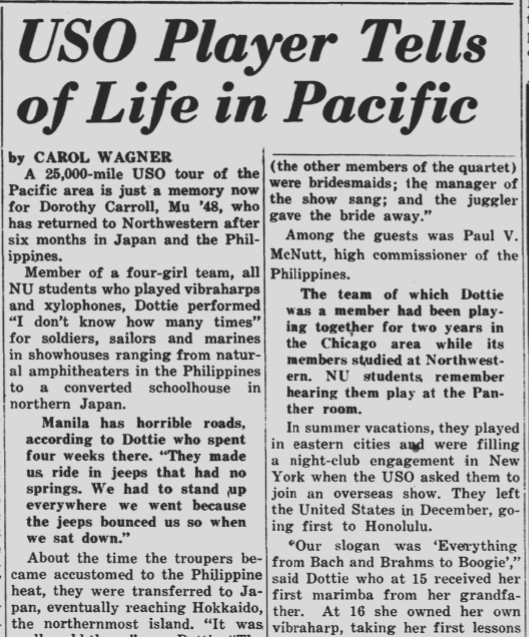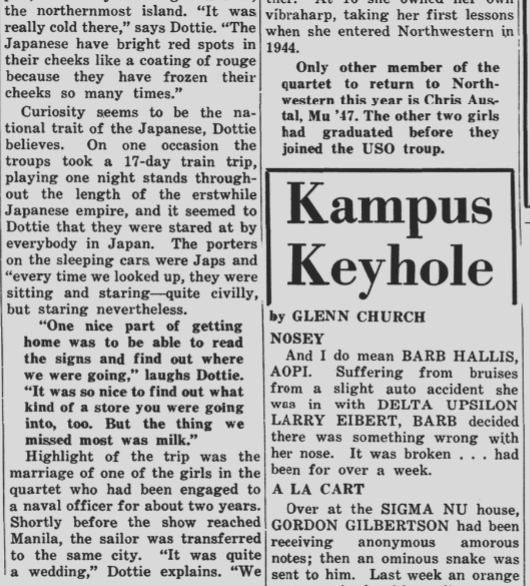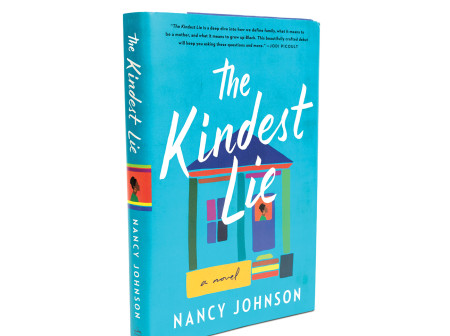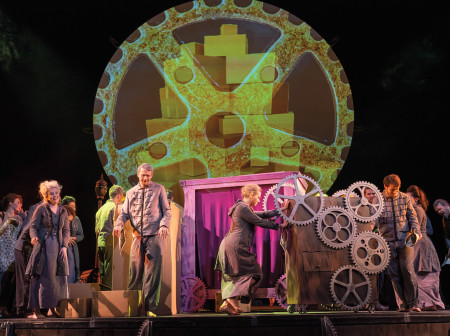In the early 1940s, Northwestern became the first U.S. university to offer a major and master’s degree in (drumroll please) … marimba!
Part of the percussion family, the marimba consists of wooden tone plates that are played with mallets, and it is thought to be an iteration of one of the earliest instruments ever invented. Similar to the xylophone, the marimba is known for its warmer, softer tones and a deeper range of notes.
Renowned percussionist and marimba virtuoso Clair Omar Musser, a hugely influential conductor and composer, began teaching marimba at Northwestern in 1942 and served on faculty for a decade. Under his tutelage, several student marimba groups formed at Northwestern in the 1940s, including the Marimba Coeds (also called the Marimba Madcaps), an all-women orchestra. The group included seven members: Dorothy Carroll ’48, Betty Atterberry Chandler ’49, Margaret Elliston ’48, Jo McWethy Kostuck ’50, Jean McWethy Matar ’48, Christine Austell Moore ’47 and Jean Smith Scott ’47. Together they toured the U.S. and Canada and performed at venues such as Carnegie Hall.
A rare video, above, shows the Marimba Coeds performing “Hora Staccato” at Northwestern’s Lutkin Hall in 1947. According to archival materials from 1948, it is perhaps the earliest video recording of the group.
“I was just gifted with footage of my mother performing that I’d never seen,” Dorothy Carroll’s daughter, Rebecca, wrote on Twitter. “This is precious to me to see her play in her younger days. She looks so happy!”
Several members of the Marimba Coeds, including Carroll and Moore, traveled to the Philippines and Japan in 1946 for a six-month USO tour to perform their music for homesick soldiers just after the end of World War II. (See newspaper clipping below from The Daily Northwestern, Nov. 19, 1946.)


In the 1940s Chicago became a leader in popularizing marimba music in the U.S., thanks in large part to Musser, who was known for organizing enormous orchestras, at times comprising hundreds of marimba players. For example, Musser organized a 100-piece marimba performance at the Chicago World’s Fair in 1933–34. He also composed original marimba music, which was near-nonexistent at the time due to the instrument’s relative rarity, and he is credited with innovating grip techniques for marimba players, including the “Musser grip,” which involves holding two mallets in each hand.



Reader Responses
There's an interesting synergy here between this story and my new position as executive director and curator for the Center for Mallet Percussion Research at Kutztown University and my work as founder and executive director of Heartland Marimba, which includes performing as the lead artist with the HM Quartet.
We prominently feature the Marimba Madcaps (Coeds) in our exhibits at the center, and of course Clair Omar Musser was their teacher at Northwestern from 1942 to 1952. We have an entire exhibit room devoted to his work. He was central to directing and organizing other iconic marimba projects such as the 100-member International Marimba Symphony Orchestra (IMSO) to name one.
And, as a bizarre bit of serendipity, Musser designed a set of marimba mallets for the IMSO project in 1935 that were manufactured by the Deagan Company in Chicago. The mallets were wrapped in gray yarn, with different colors used in a single row stitching to distinguish the different articulations in the series (six levels). In 2021 I released a set of six signature marimba mallets produced by JG Percussion (San Diego) that were designed with virtually the same concepts and aesthetics. I wasn't aware of the 1935 mallets until I saw a set that's in our collection at the center earlier this year while I was setting up the Musser Exhibit room.
—Matthew Coley '03 MMus, '13 DMA, Waterloo, Iowa, via Northwestern Magazine
This is an incredible find. Mr. Musser is my distant cousin, and having been a percussion major 60 years later at Northwestern, this is great to see. We still use Musser instruments today in the San Francisco Symphony.
—Jacob Nissly '05, San Francisco, via Northwestern Magazine
Dorothy was my neighbor, her home was always filled with music.
The best of memories.
—Pamela Moss Bluff, La.
Thanks so much for sharing! Dorothy Carroll was my grandma, and I really loved reading about her and seeing this video.
—Laura Jacksonville, Fla.
Love the Marimba story. Thanks for sharing this.
—Barbara McStowe Wilmette, Ill.
No one has commented on this page yet.
Submit a Response